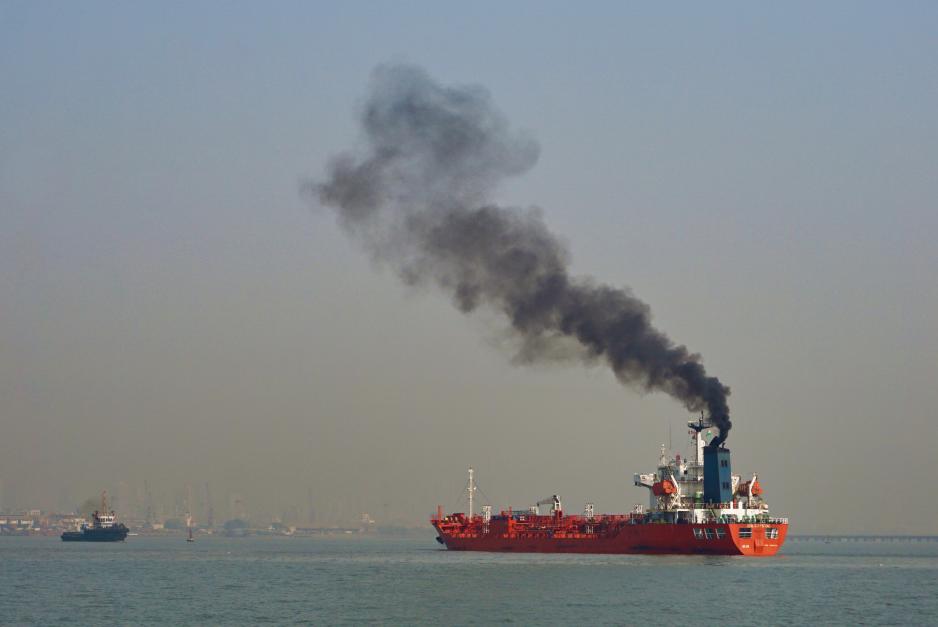Russia and Canada Opt Out of Voluntary Heavy Fuel Oil Ban for Arctic

Cargo ship emitting black carbon. (Source: Cyprien Hauser CC BY-ND 2.0)
Russia and Canada will not be acceding to the International Maritime Organization’s 2024 prohibition on heavy fuel oil. Canada’s move is likely only temporary until it can formally adopt the underlying agreement, while Russia aims to use heavy fuel oil for at least five more years.
In a move that signals Russia’s desire to continue using and transporting heavy fuel oil (HFO) in the Arctic until a mandatory ban comes into effect for all vessels in mid-2029, the country informed the International Maritime Organization (IMO) that it is opting out of voluntary restrictions on HFO which are set to begin in mid-2024.
Russia informed the IMO last month that “the amendments as adopted by the Resolution MEPC.329(76) will not enter into force for the Russian Federation on the 1st of November, 2022”. Canada similarly notified the IMO that it will not be acceding to the protocol, until it has had a chance to finalize the adoption of the treaty.
Under the International Convention for the Prevention of Pollution from Ships (MARPOL) a ban on the use and carriage of HFO had been discussed in the IMO for more than a decade until it was agreed upon in 2021. The ban will take effect for non-Arctic flagged vessels in 2024.
However, due to resistance for a total ban by Russia, vessels flying the flag of an Arctic state were granted a 5-year grace period until they also have to comply by mid-2029. Double-hulled vessels, which are deemed safer, are also exempt until 2029.
HFO remains in Arctic until end of decade
HFO is the dirtiest type of marine fuel and, in case of a spill, poses substantial risk to the Arctic Ocean’s sensitive ecosystem.
This type of fuel also produces high levels of black carbon, or soot, which when it settles on snowy surfaces across the region contributes disproportionately to ice melt. It is also near-impossible to clean up, especially in colder environments or waters, where it becomes thick and viscous.
The article continues below
The regulation was originally designed to quickly and substantially reduce the number of vessels traveling across the Arctic either using HFO in their engines or transporting the fuel across the region.
At the time the resolution was adopted environmental advocacy groups warned that the ability for Arctic states to waive requirements by another five years was a substantial loophole which rendered the entire regulation much less effective.
Russian-flagged vessels account for the vast majority of shipping in the Arctic. Along the country’s Northern Sea Route (NSR), the busiest shipping lane in the region, out of 941 ships that received permits in 2022, 902 were flying the Russian flag. These ships will be exempt from the HFO requirements until mid-2029 or until Russia accedes to the voluntary protocol.
More crude shipped across Arctic
The ton mileage in the Arctic is likely to increase in 2023 and beyond sending crude oil and other hydrocarbon fuels on lengthier voyages to Asia, rather than Europe, as a result of sanctions. With the EU sanctions banning seaborne imports of Russia crude oil, the country will redirect at least some of its crude oil to flow toward the east.
Much of this production will flow toward Asia
Ships carrying oil over longer distances and through the more icy waters of the eastern NSR enhance the risk oil tanks face during their voyage to Asia.
The Vasily Dinkov, an ice-strengthened oil tanker, is currently transporting crude oil from near Murmansk via the NSR to the Chinese port of Rizhao, where it is due to arrive later this week on November 17. It is only the second time this type of voyage with crude oil has been conducted.
However, analysts expect that with Europe closed off to Russian oil imports, the NSR 2023 will see more voyages like the Vasily Dinkov.
Once Rosneft's Vostok oil project begins production in 2024 a massive 500,000 barrels of crude per day could be produced in the western part of Russia’s Arctic. With EU sanctions likely still in place at that time, much of this production will flow toward Asia.
Not only will vessels carry large quantities of crude oil through the Arctic, based on Russia’s decision to not accede to voluntary protocol, tankers will also be able to continue to use HFO to power their engines until almost the end of this decade.




